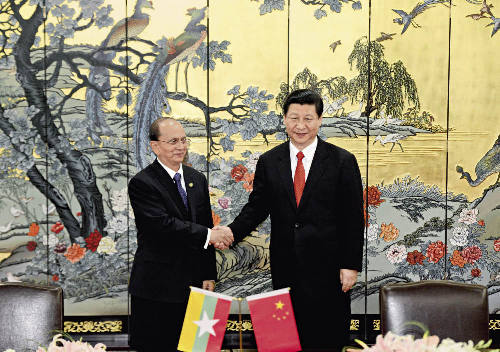By staff reporter HOU RUILI
 |
|
Chinese President Xi Jinping and Myanmese President U Thein Sein at the signing ceremony on April 5, 2013, in Sanya City, Hainan Province, of a series of bilateral cooperation agreements. |
By staff reporter HOU RUILI
 |
|
Chinese President Xi Jinping and Myanmese President U Thein Sein at the signing ceremony on April 5, 2013, in Sanya City, Hainan Province, of a series of bilateral cooperation agreements. |
ALONG the 2,100-odd-kilometer border between China and Myanmar, people living on the frontiers build increasingly closer ties. They do business with and marry each other. They become friends and relatives and together, they worship Buddha and chant scriptures, living as brothers and sisters. What is interesting is that many of the villages in the border regions are half Chinese and half Myanmese. In Yinjin Village, for example, there is a well that is visited by people coming to fetch water every day – and those visitors include both Chinese and Myanmese people, each considering the other not as foreigners but as compatriots.
When the boundary marker was erected, it was built in the backyard of a local Dai family at Tunhong Ferry in Ruili City, Yunnan Province, creating a unique situation of “one family, two countries.” A look at the history of Sino-Myanmese relations as well as the current state of affairs shows that this idea extends to the two nations, too.
Long-standing Friendship
According to the Treatise on Geography of Hanshu, or History of the Han Dynasty, Sino-Myanmese ties began when businessmen from China’s inland provinces such as Sichuan and Hubei opened up a road to link Sichuan and Yunnan with India and Myanmar. It was called the “Gold and Silver Road” by the Myanmese. Along this road, Chinese tradesmen transported Ramie fabric, silk and porcelain to countries such as Myanmar, India and Afghanistan.
As early as AD 94 during the Eastern Han Dynasty (25-220), the kingdoms of different tribes in Myanmar repeatedly sent envoys to China. In the Yuan (1271-1368), Ming (1368-1644) and Qing (1644-1911) dynasties, many mutual diplomatic exchanges were conducted. The close friendship that has been developing for over 2,000 years has led the Myanmese to consider the Chinese as their compatriots and relatives.
In modern times, people of China and Myanmar have supported each other in their fights for national independence. In 1885, British colonists launched the Third Anglo-Myanmese War, occupying Mandalay, the last royal capital of Myanmar. The king, Thibaw Min, was captured and exiled and Myanmar came under the rule of the British Raj as a province of India. After the imperial palace in Mandalay was occupied, King Thibaw’s grandson immediately mobilized the people to fight against the British invaders. However, after a four-year-long resistance, he failed. He retreated with the remaining troops to China, where they received both shelter and help from the Chinese people. The hero of this war, who lived into his 80s, wished to be buried in China and his tomb is in today’s Mangshi of Dehong Dai and Jingpo Autonomous Prefecture in Yunnan Province.
During World War II, the people of Myanmar and China co-built the Dianmian Highway, devoting their lives to its construction. It has been described as China’s lifeline during the war against Japanese aggression. Thanks to active support from overseas Chinese in Southeast Asian nations and the Myanmese people, international aid could be transported along this route to the battlefields, providing powerful support.
In January 1942, Japanese invaders stormed Myanmar to cut off the Dianmian Highway. The Chinese Expeditionary Force, consisting of 100,000 soldiers, went to Myanmar and fought a bloody battle against the Japanese troops. Over 60,000 heroic martyrs were buried forever in Myanmar.
In the anti-Japanese battlefields of western Yunnan and Myanmar, people of China and Myanmar worked together with the allied forces to combat the Japanese aggressors and finally achieved victory, driving the Japanese out of Myanmar.